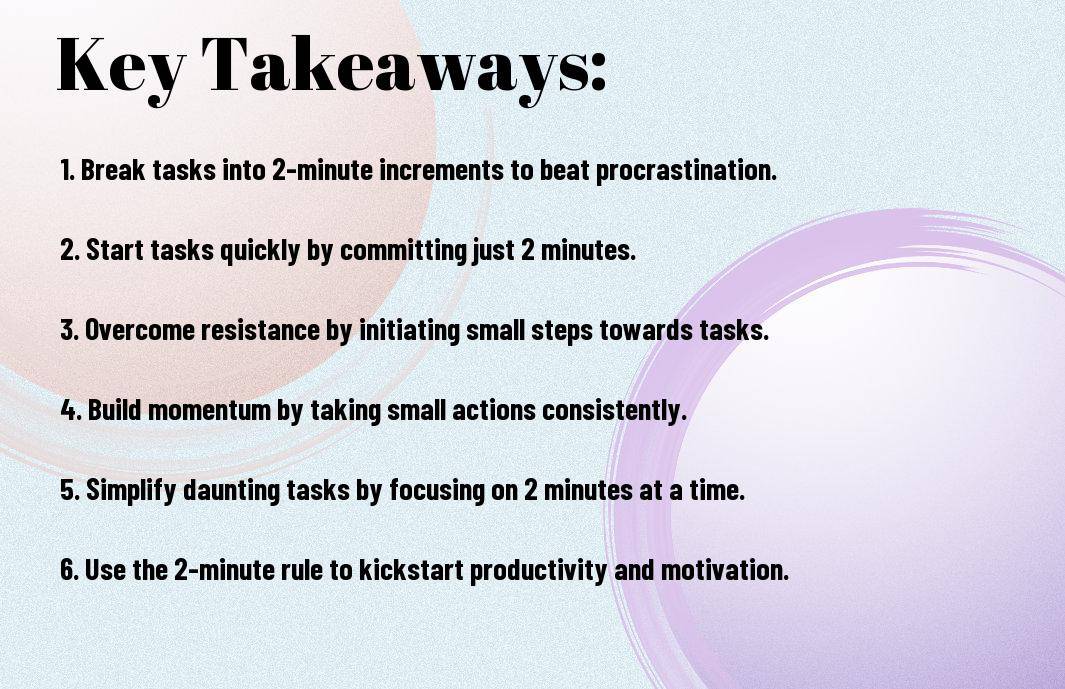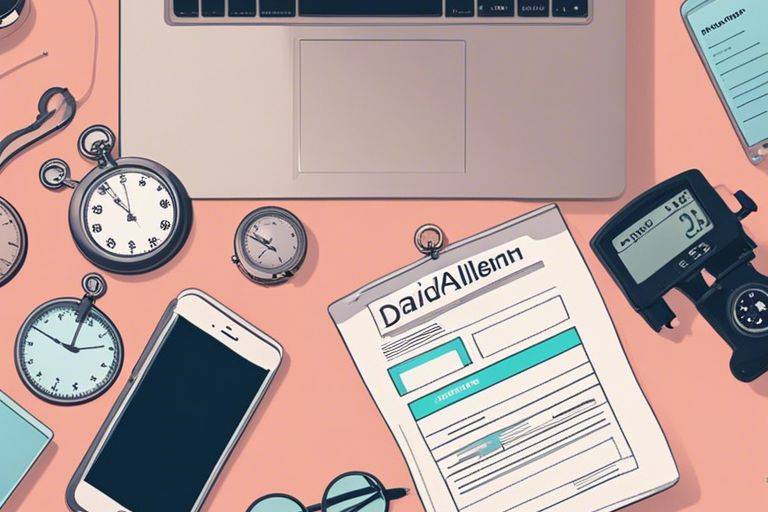The 2 Minute Rule! Productivity experts often stress the importance of overcoming procrastination to achieve success in both personal and professional endeavors. One powerful strategy that has gained traction in recent years is the 2 Minute Rule popularized by productivity guru David Allen. This rule is a simple yet effective technique designed to help individuals break the cycle of procrastination and start tasks that they may have been putting off.

Key Takeaways:
- Break tasks into 2 minute increments: The 2-Minute Rule suggests breaking down tasks into smaller, manageable chunks that take only 2 minutes to start.
- Overcome procrastination: By focusing on starting a task rather than completing it, the 2 Minute Rule helps overcome the inertia of procrastination.
- Build momentum: Starting a task can often lead to momentum, making it easier to continue working on it beyond the initial 2 minutes.
- Reduce overwhelm: Breaking tasks into 2 minute increments can help reduce feelings of overwhelm, making it easier to get started.
- Establish a habit: Consistently applying the 2 Minute Rule can help establish a habit of starting tasks promptly, leading to increased productivity over time.
- Apply to various tasks: The 2 Minute Rule can be applied to a wide range of tasks, from work projects to personal goals, making it a versatile productivity tool.
- Boost motivation: By lowering the barrier to entry for tasks, the 2 Minute Rule can boost motivation and make it easier to tackle larger and more challenging projects.

Origins of the 2 Minute Rule
One of the most popular productivity techniques, the 2 Minute Rule, has helped countless individuals overcome procrastination and kickstart their tasks. This simple yet effective rule was popularized by productivity guru David Allen, known for his best-selling book ‘Getting Things Done’.
David Allen and ‘Getting Things Done’
To understand the origins of the 2 Minute Rule, we must investigate into the principles outlined in David Allen’s renowned book ‘Getting Things Done’. Allen emphasizes the importance of breaking down tasks into manageable components to increase productivity and reduce overwhelm. The 2 Minute Rule is a key concept derived from this methodology, encouraging individuals to tackle tasks that can be completed in two minutes or less immediately.
Philosophical Underpinnings of Quick Action
Underpinnings of quick action are rooted in the philosophy that taking immediate, small steps towards a goal can lead to significant progress over time. This approach is particularly effective in combating inertia and procrastination, as it capitalizes on momentum and fosters a sense of accomplishment.
Rule

Understanding the 2 Minute Rule
The Basic Premise of the Rule
Minute tasks can often pile up and create a sense of overwhelm, leading many to procrastinate. The 2 Minute Rule, popularized by productivity expert David Allen, offers a simple solution to this common problem. The premise of the rule is straightforward: if a task can be completed in two minutes or less, do it immediately.
This approach is designed to eliminate the mental energy wasted on deciding when to do quick tasks. By taking immediate action on these small tasks, individuals can prevent them from accumulating into a larger, more daunting list of to-dos. Embracing this rule can help establish a proactive mindset and increase productivity in the long run.
When to Use the 2 Minute Rule
To maximize the effectiveness of the 2 Minute Rule, it’s important to apply it strategically. Tasks that fall under the two-minute mark are typically simple and don’t require extensive planning or preparation. These can include responding to emails, organizing a workspace, or making a quick phone call. By utilizing the 2 Minute Rule for such tasks, individuals can clear their plate of minor responsibilities efficiently.
A key point to remember is that the 2 Minute Rule is not meant to tackle complex or time-consuming tasks. It is best suited for quick wins that can be completed without significant effort. By prioritizing these small tasks, individuals can create momentum and build a sense of accomplishment that propels them towards bigger goals.
The Psychology Behind the 2 Minute Rule
Overcoming the Initial Resistance
Psychology plays a crucial role in understanding why the 2 Minute Rule is so effective in overcoming procrastination. All tasks, no matter how big or small, can trigger a sense of resistance or overwhelm when we think about starting them. This resistance is often fueled by the fear of failure, perfectionism, or simply the discomfort of stepping out of our comfort zones. By breaking tasks down into 2 minute increments, we bypass this initial resistance and make it easier to get started.
The Role of Habit Formation in Task Initiation
Psychology research has shown that our brains are wired to seek out patterns and efficiencies through habit formation. Any behavior that is repeated consistently can become automatic over time, making it easier for us to initiate tasks without much thought or effort. By adopting the 2 Minute Rule and turning it into a habit, we train our brains to associate starting tasks with minimal effort, paving the way for increased productivity and efficiency.
Habit: Developing the habit of starting tasks with the 2 Minute Rule can have transformative effects on our ability to overcome procrastination and boost our productivity. By consistently dedicating just 2 minutes to initiating a task, we create positive momentum that can carry us through to completion, empowering us to tackle even the most daunting of tasks with ease.
Implementing the 2 Minute Rule Effectively
Identifying 2 Minute Tasks in Your Routine
Unlike traditional approaches that emphasize tackling big tasks first, the 2 Minute Rule focuses on taking immediate action on tasks that can be completed in just two minutes or less. Identifying these micro-tasks in your daily routine is crucial to making the most of this productivity hack. These tasks may include responding to quick emails, jotting down a grocery list, or setting up a meeting reminder.
Strategies for Applying the Rule
One effective strategy for applying the 2 Minute Rule is to compile a list of these short tasks and designate a specific time during your day to address them. By clustering these tasks together, you can efficiently knock them out and clear your mental clutter. Additionally, pairing 2 minute tasks with habitual actions like making coffee in the morning or waiting for a bus can help integrate productivity seamlessly into your daily routine.
Applying the 2 Minute Rule can lead to a significant reduction in procrastination and a boost in productivity. By breaking down larger tasks into smaller, manageable chunks, you can overcome the inertia that often accompanies starting a new project or assignment.
Integrating the Rule into Various Aspects of Life
With the 2 Minute Rule, you can integrate productivity into various aspects of your life, from personal to professional. Whether it’s tidying up your workspace, paying bills, or sending a follow-up email, applying the 2 Minute Rule consistently can lead to a more organized and efficient lifestyle. By incorporating this rule into your daily routines, you can build momentum and cultivate a habit of taking immediate action.
Tasks that may seem daunting at first glance can be easily tackled by breaking them down into 2 minute increments. This approach not only helps get things done but also provides a sense of accomplishment and motivation to tackle more challenging tasks.
The Impact of the 2 Minute Rule on Productivity
Your productivity can skyrocket by implementing the 2 Minute Rule, a concept popularized by David Allen. This rule states that if a task takes less than 2 minutes to complete, you should do it immediately. The impact of this rule on your workflow can be significant, leading to increased efficiency and decreased procrastination.
Short-term and Long-term Benefits to Workflow
On implementing the 2 Minute Rule, you will notice immediate improvements in your productivity. By tackling quick tasks right away, you clear your to-do list rapidly, creating a sense of accomplishment and momentum. In the long term, this practice helps in building a habit of taking action promptly, leading to better time management skills and increased overall productivity.
Case Examples of Improved Efficiency
Short-term wins like sending a quick email, making a brief phone call, or organizing a small work space can lead to significant improvements in efficiency. By applying the 2 Minute Rule consistently, individuals have reported a notable decrease in the feeling of being overwhelmed by their workload. This simple yet powerful strategy can revolutionize how you approach tasks, resulting in a more streamlined workflow and better time utilization.
Understanding the 2 Minute Rule and its impact on productivity can transform the way you work. By honing in on quick wins and addressing small tasks promptly, you set yourself up for success in both the short and long term.
Limitations and Criticisms of the 2 Minute Rule
Many productivity enthusiasts swear by the 2 Minute Rule for its effectiveness in jumpstarting productivity and overcoming procrastination. However, like any strategy, it has its limitations and criticisms that are important to recognize to ensure its successful application in various situations.
When the Rule May Not Work
Criticisms of the 2 Minute Rule often point out that it may not be as effective for tasks that require deep focus or significant time investment. Tasks that involve complex problem-solving, creative brainstorming, or in-depth research may not fit neatly into the 2 minute timeframe. Additionally, some individuals may find it challenging to accurately estimate the time a task will take, leading to frustration if they underestimate and cannot complete it within the 2 minute limit.
Responses to Criticisms
Work To address these criticisms and limitations, it is vital to understand that the 2 Minute Rule is just one tool in a productivity toolbox. While it excels at tackling small, manageable tasks that often get pushed aside, it may not be suitable for every type of task. It is crucial to use discretion and adapt the rule to fit the specific demands of a task or project, knowing when to break it down into smaller steps or allocate dedicated time for more complex tasks. By combining the 2 Minute Rule with other time management techniques, individuals can maximize its benefits while acknowledging its limitations.

Extending Beyond the 2 Minute Rule
Not every task can be completed in just 2 minutes, especially when it comes to larger tasks and projects. However, the principle of the 2 Minute Rule can still be applied to these bigger endeavors to make them more manageable and less overwhelming.
Building Up from 2 Minutes: Larger Tasks and Projects
The key to tackling larger tasks and projects is to break them down into smaller, more manageable sub-tasks that can be accomplished in 2 minute increments. By taking the time to create a detailed plan or outline of the steps involved, you can make progress on these more significant endeavors without feeling discouraged or stuck. Bear in mind, progress, no matter how small, is still progress.
Complementary Techniques and Methods
Methods such as the Pomodoro Technique, time blocking, and the Eisenhower Matrix can complement the 2 Minute Rule by providing structure, prioritization, and focus to your workflow. By combining these techniques with the 2 Minute Rule, you can increase your productivity and efficiency while minimizing distractions and procrastination.
Methods
Exploring additional methods and techniques can help you tailor your productivity approach to suit your unique working style and preferences. Experiment with different strategies to find what works best for you and incorporate them into your daily routine for optimal results.
Summing up
On the whole, the 2 Minute Rule, popularized by productivity guru David Allen, is a simple yet powerful strategy to overcome procrastination and kickstart tasks that we tend to put off. By breaking down tasks into small, manageable two-minute increments, this technique tricks the brain into initiating action. It helps individuals tackle daunting projects with less resistance, ultimately fostering a habit of productivity and consistency. To learn more about how to implement this rule in your daily routine, check out How to Use the the “2 Minute Rule” to Stop Procrastinating.
FAQ
Q: What is the 2 Minute Rule?
A: The 2 Minute Rule is a productivity strategy popularized by David Allen, which states that if a task can be completed in under 2 minutes, it should be done immediately rather than postponed.
Q: How does the 2 Minute Rule help overcome procrastination?
A: By following the 2 Minute Rule, individuals can avoid procrastination by breaking down tasks into smaller, more manageable steps that can be completed quickly and easily.
Q: What are some examples of tasks that can be done in under 2 minutes?
A: Responding to an email, putting away dishes, making a quick phone call, or jotting down a short to-do list are all examples of tasks that can typically be completed in under 2 minutes.
Q: How can I implement the 2 Minute Rule in my daily routine?
A: Make a habit of identifying small tasks that can be done quickly and commit to completing them as soon as they arise. Set aside designated time intervals throughout the day to tackle these tasks.
Q: What are the benefits of using the 2 Minute Rule?
A: The 2 Minute Rule increases productivity, reduces the feeling of being overwhelmed by a long to-do list, and helps cultivate a habit of completing tasks promptly.
Q: Can the 2 Minute Rule be applied to larger tasks as well?
A: While the 2 Minute Rule is primarily aimed at small, quick tasks, it can also be adapted for larger tasks by breaking them down into smaller, 2 minute segments or identifying the first small step to get started.
Q: How can I stay motivated to consistently apply the 2 Minute Rule?
A: Celebrate your small wins, track your progress, and remind yourself of the benefits of completing tasks promptly. Over time, the positive results of using the 2 Minute Rule will help motivate you to continue using this strategy.
Expand Your Knowledge
Time Blocking – The Ultimate Guide to Allocating Specific Time Slots for Tasks
Zero-Based Calendar – Strategically Schedule Every Minute for Unparalleled Productivity
The One Thing – Gary Keller and Jay Papasan’s Focus on Making Everything Else Easier
Timeboxing – The Effective Limitation of Time Spent on Tasks



